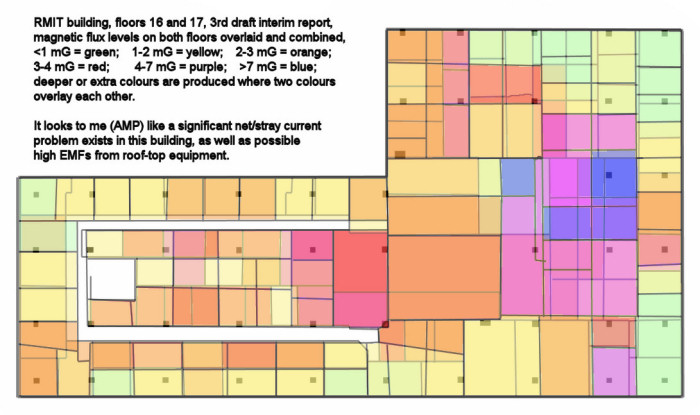 |
 |
|
 |
 |
About Us | Contact |
|
|
21/06/2006 - Phone Masts Incorrectly ImplicatedIn early May 2006, RMIT University, Melbourne, took the unprecedented step of vacating the two top floors of building 108 at its Bourke Street campus. This was in response to five staff members in April and May 2006 being found to have brain tumours, as well as two others in 1999 and 2001. Two were malignant and five were benign. Five of the seven cases worked on the top floor of the building and all but one worked in the building for the past 10 years. The other two cases were located on floors 11 and 14. The media stated that mobile phone base stations on the roof of the building were the suspected cause. As a result of the two earlier cases, in 2001 an investigation was conducted that apparently found no unusual factors that could be attributed to the tumour cases. A new study by EMC Technologies Pty Ltd has been carried out and released by RMIT. Don Maisch (EMFacts, see below) has now completed his separate paper into the incident, which can be found at the following location: [Link to Don Maisch's separate report (138 KB pdf file)] The levels of mobile phone base stations were vanishingly small and we believe these are most unlikely to be a contributory factor. The same applies to the unlicensed WIMAX transmitters on the roof. However, they measured power-frequency magnetic fields in many rooms above the 0.4 microtesla already associated with childhood leukaemia. A number of studies of adult brain cancer have also implicated power-frequency magnetic fields. We do not know what rooms the victims worked in, but here is a plot of the fields in the top two floors (16 and 17):  Powerwatch believes that these show net/stray current problems with the wiring in the building. We have investigated numbers of commercial buildings (and cured high magnetic field problems) and we believe there is no excuse for magnetic field levels above about 0.25 microtesla; indeed, many international corporations already have their new buildings designed so that their employees are not generally exposed to fields above this level. There also look to be high magnetic fields coming from an equipment cabin on the roof - probably air-conditioning. This should be investigated to see why the fields as so high as to significantly raise the EMFs two floors below. It should be remembered that brain tumours are generally not diagnosed until at least 10 and often up to 30 years after they have been initiated. This means that EMFs may have just been a contributory promotional factor and maybe something like a release of radioactive gas occurred about 10 years ago, which when distributed by the air-conditioning system of the building could have been the cause of the cluster. Whilst we believe that mobile phone base stations are very hazardous to public health, especially when close to residential buildings, we are concerned that they do not get unjustly blamed for health problems. Alasdair Philips With thanks to Don Maisch, EMFacts Consultancy,Tasmania: www.emfacts.com Also in the newsHeavy industry bias in the ICNIRP groupAlso covered by Don Maisch, this is an interesting article covering the number of members of ICNIRP - a supposedly independent expert group - and their ties with corporate industries. [Link to PDF (36 KB) on www.emfacts.com] Church of England controversially supports nationwide installation of phone masts in churchesThis seems to have been the cause of quite some controversy in this country, but the Church of England have officially signed up to having masts installed at the top of a number of churches. Whilst there is the issue of the issue of the ever increasing number of masts, the people within a church are likely to be quite safe from the mast emissions due to the way the signal is broadcast. If they are going up at all, this seems to be both an out of sight place and one which keeps the masts in as high up location as possible, which are both better than the alternative of having more around street level in our towns. [Link to the latest update on the contract with QS4 - the company responsible for the installation of wireless telecommunications in churches] This page has links to content that requires a .pdf reader such as |

